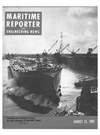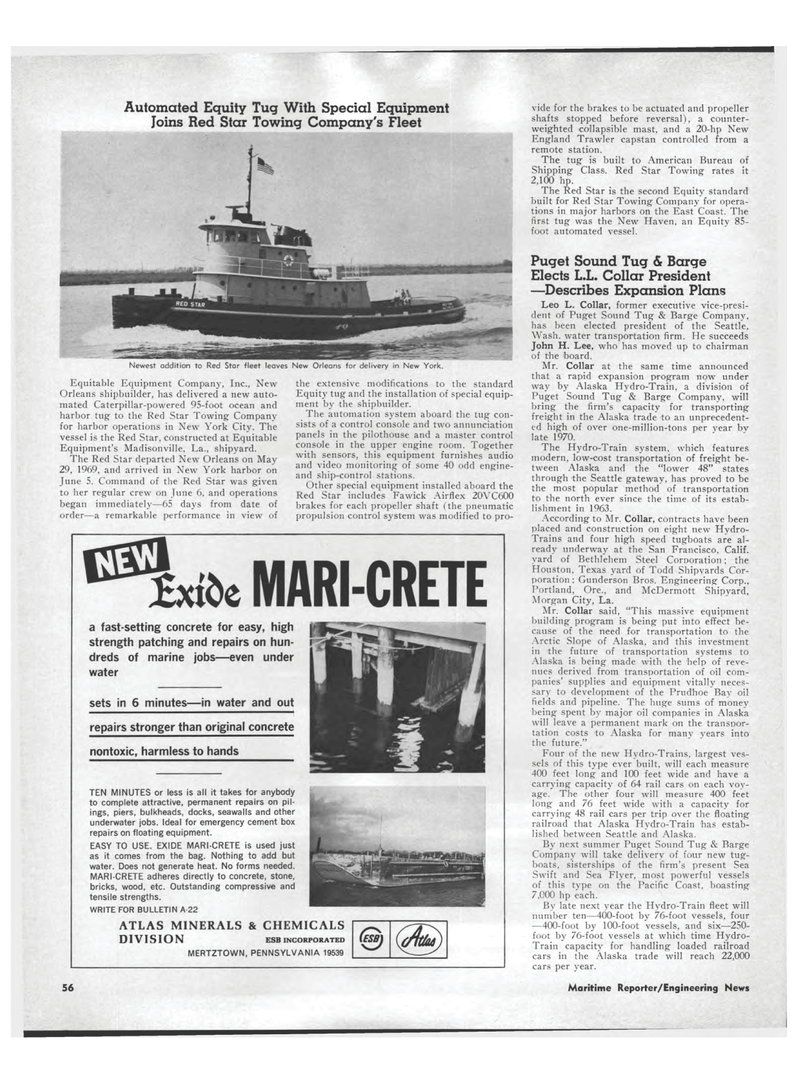
Page 54: of Maritime Reporter Magazine (August 15, 1969)
Read this page in Pdf, Flash or Html5 edition of August 15, 1969 Maritime Reporter Magazine
Automated Equity Tug With Special Equipment Joins Red Star Towing Company's Fleet Newest addition to Red Star fleet leaves New Orleans for delivery in New York. Equitable Equipment Company, Inc., New Orleans shipbuilder, has delivered a new auto-mated Caterpillar-powered 95-foot ocean and harbor tug to the Red Star Towing Company for harbor operations in New York City. The vessel is the Red Star, constructed at Equitable Equipment's Madisonville, La., shipyard. The Red Star departed New Orleans on May 29, 1969, and arrived in New York harbor on June 5. Command of the Red Star was given to her regular crew on June 6, and operations began immediately?65 days from date of order?a remarkable performance in view of the extensive modifications to the standard Equity tug and the installation of special equip-ment by the shipbuilder. The automation system aboard the tug con-sists of a control console and two annunciation panels in the pilothouse and a master control console in the upper engine room. Together with sensors, this equipment furnishes audio and video monitoring of some 40 odd engine-and ship-control stations. Other special equipment installed aboard the Red Star includes Fawick Airflex 20VC600 brakes for each propeller shaft (the pneumatic propulsion control system was modified to pro-vide for the brakes to be actuated and propeller shafts stopped before reversal), a counter-weighted collapsible mast, and a 20-hp New England Trawler capstan controlled from a remote station. The tug is built to American Bureau of Shipping Class. Red Star Towing rates it 2,100 hp. The Red Star is the second Equity standard built for Red Star Towing Company for opera-tions in major harbors on the East Coast. The first tug was the New Haven, an Equity 85-foot automated vessel. Puget Sound Tug & Barge Elects L.L. Collar President ?Describes Expansion Plans Leo L. Collar, former executive vice-presi-dent of Puget Sound Tug & Barge Company, has been elected president of the Seattle, Wash, water transportation firm. He succeeds John H. Lee, who has moved up to chairman of the board. Mr. Collar at the same time announced that a rapid expansion program now under way by Alaska Hydro-Train, a division of Puget Sound Tug & Barge Company, will bring the firm's capacity for transporting freight in the Alaska trade to an unprecedent-ed high of over one-million-tons per year bv late 1970. The Hydro-Train system, which features modern, low-cost transportation of freight be-tween Alaska and the "lower 48" states through the Seattle gateway, has proved to be the most popular method of transportation to the north ever since the time of its estab-lishment in 1963. According to Mr. Collar, contracts have been placed and construction on eight new Hydro-Trains and four high speed tugboats are al-ready underway at the San Francisco. Calif, yard of Bethlehem Steel Corporation; the Houston, Texas yard of Todd Shipyards Cor-poration ; Gunderson Bros. Engineering Corp., Portland, Ore., and McDermott Shipyard, Morgan City, La. Mr. Collar said, "This massive equipment building program is being put into effect be-cause of the need for transportation to the Arctic Slope of Alaska, and this investment in the future of transportation systems to Alaska is being made with the help of reve-nues derived from transportation of oil com-panies' supplies and equipment vitally neces-sary to development of the Prud'hoe Bay oil fields and pipeline. The huge sums of money being spent by major oil companies in Alaska will leave a permanent mark on the transpor-tation costs to Alaska for many years into the future." Four of the new Hydro-Trains, largest ves-sels of this type ever built, will each measure 400 feet long and 100 feet wide and have a carrying capacity of 64 rail cars on each voy-age. The other four will measure 400 feet long and 76 feet wide with a capacity for carrying 48 rail cars per trip over the floating railroad that Alaska Hydro-Train has estab-lished between Seattle and Alaska. By next summer Puget Sound Tug & Barge Company will take delivery of four new tug-boats, sisterships of the firm's present Sea Swift and Sea Flyer, most powerful vessels of this type on the Pacific Coast, boasting 7.000 hp each. By late next year the Hydro-Train fleet will number ten?400-foot by 76-foot vessels, four -400-foot by 100-foot vessels, and six?250-foot by 76-foot vessels at which time Hydro-Train capacity for handling loaded railroad cars in the Alaska trade will reach 22,000 cars per year. ^xtte MARI-CRETE a fast-setting concrete for easy, high strength patching and repairs on hun-dreds of marine jobs?even under water sets in 6 minutes?in water and out repairs stronger than original concrete nontoxic, harmless to hands TEN MINUTES or less is all it takes for anybody to complete attractive, permanent repairs on pil-ings, piers, bulkheads, docks, seawalls and other underwater jobs. Ideal for emergency cement box repairs on floating equipment. EASY TO USE. EXIDE MARI-CRETE is used just as it comes from the bag. Nothing to add but water. Does not generate heat. No forms needed. MARI-CRETE adheres directly to concrete, stone, bricks, wood, etc. Outstanding compressive and tensile strengths. WRITE FOR BULLETIN A-22 ATLAS MINERALS & CHEMICALS DIVISION ESB INCORPORATED MERTZTOWN, PENNSYLVANIA 19539 56 Maritime Reporter/Engineering News

 53
53

 55
55
